Are you tired of feeling like you’re on a wobbly amusement park ride every time you walk around your RV? Look no further, as we have the perfect solution for you: stabilizer jacks! In this comprehensive guide, we’ll explore the world of RV stabilizer jacks, discuss various types, share our top recommendations, and provide you with all the know-how to eliminate the dreaded sway. So, buckle up and join us on this exciting ride to RV stability!
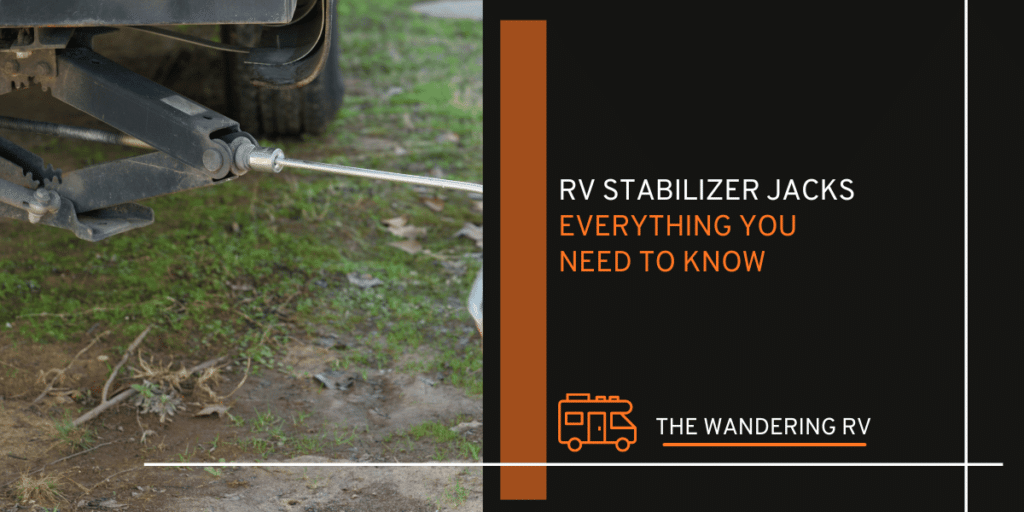
Table of Contents
- What Are RV Stabilizer Jacks?
- Do RVs Need Stabilizers?
- What is the Difference Between Stabilizing Jacks and Leveling Jacks?
- Can You Level a Camper With Stabilizer Jacks?
- 10 Types of RV Stabilizer Jacks
- Bonus: Accessories
- So Which Camper Stabilizer is Best?
- Frequently Asked Questions
What Are RV Stabilizer Jacks?
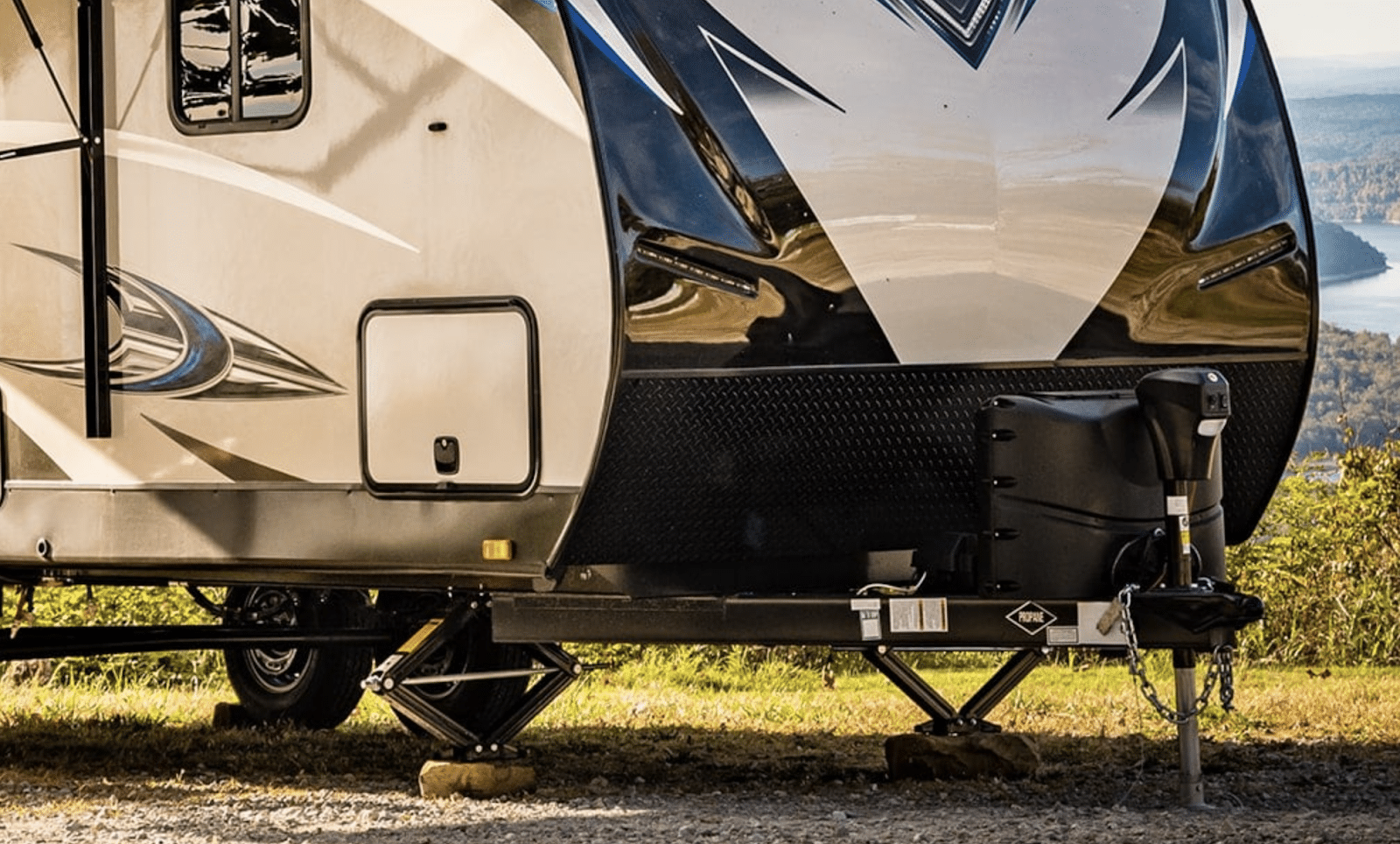
Simply put, RV stabilizing jacks extend from the frame of an RV to the ground in order to reduce the movement sometimes felt in an RV.
Tons of RVers (ourselves included) will use wooden blocks, wheel chocks, or plastic leveling jacks to help reduce the amount you have to extend an RV stabilizer jack (as you really shouldn’t overextend stabilizer jacks).
Some RVs and travel trailers have automatic RV stabilizer jacks. When you get to camp, simply push a button on the inside of your rig and all four stabilizer jacks extend (and retract) automatically!
Manual stabilizer jacks, however, are far more common and require you to use a hand crank (or a handheld power drill) in order to extend them.
Do RVs Need Stabilizers?
The short and sweet answer? If your RV isn’t stabilized properly, you’re going to have a difficult time moving inside of it (and there’s a chance you roll out of bed at night).
Keep in mind that your RV’s refrigerator needs to be on a leveled surface in order to work efficiently. If not, the fluids within the refrigeration system will circulate, causing it to overheat (which could lead to damage).
What is the Difference Between Stabilizing Jacks and Leveling Jacks?
One of the most common mistakes you can make is assuming that leveling jacks serve the same purpose as RV stabilizing jacks. Here’s how they’re different:
- RV Stabilizer Jacks – An RV stabilizer jack is able to support portions of your RV in order to absorb the shifting you may feel as you walk around in your rig. While they can’t fully eliminate movement, they do make a noticeable difference when used properly.
- RV Leveling Jacks – As their name implies, leveling jacks help to level your RV from side to side (or front to back). These jacks help to ensure that your RV’s systems perform as they should while also providing a comfortable experience.
If you try to use either of these jacks for anything other than their intended purpose, you can damage both your jacks and RV!
Can You Level a Camper With Stabilizer Jacks?
Absolutely… not.
As we stated above, leveling jacks are much different than RV stabilizer jacks. The intended purpose of a stabilizer jack is only to stabilize your RV.
Apart from us telling you this, there’s a chance that you see warning labels telling you not to overload your jacks, too!
10 Types of RV Stabilizer Jacks
Without further ado, let’s go over what stabilizer jacks you can get on the market today (as well as what stabilizer jacks we recommend).
1. Scissor Jacks
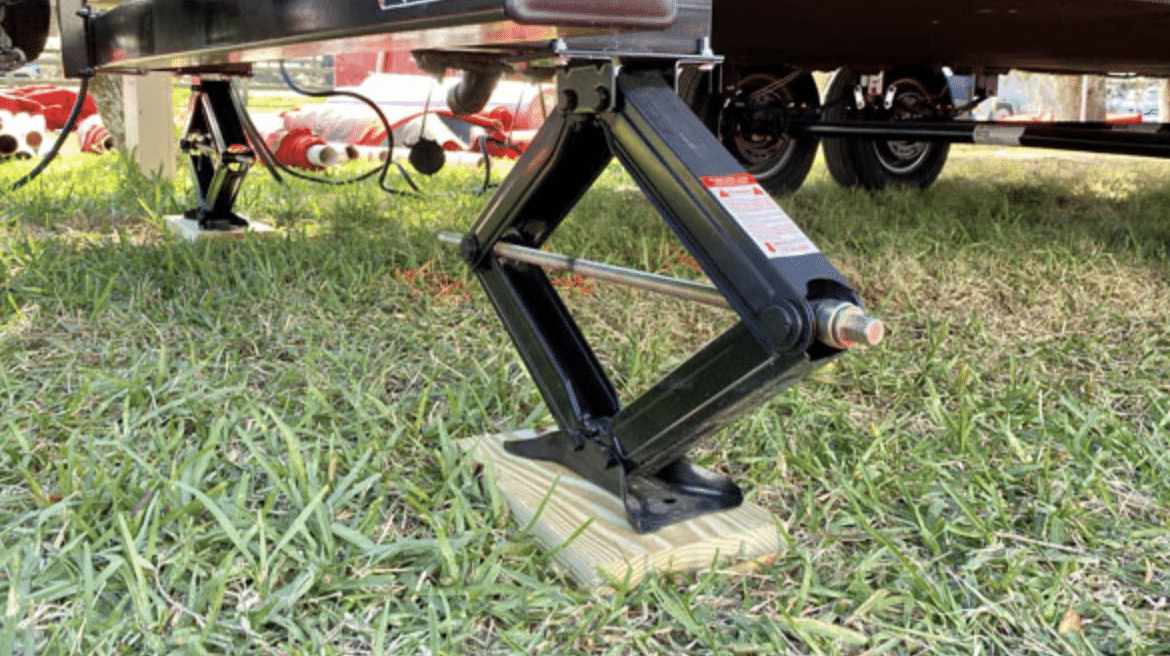
Scissor jacks are the most common stabilizer jacks you’ll see on travel trailers and older fifth wheels. For the most part, manufacturers will install scissor jacks onto their RVs because they’re cheap, simple to work, and do a good job.
Scissor jacks require you to manually raise and lower them. Typically, you’ll have a bolt that you have to tighten and loosen by using a drill or ratchet. Try not to over-tighten scissor jacks, as you risk putting too much weight on them.
If you’re looking for some awesome scissor jacks for your RV, we recommend getting the Libra RV Trailer Stabilizer Leveling Scissor Jacks:
- Stablizing and leveling your Camper, RV, Trailer, Remains steady on soft surfaces because of wide bow-tie base
- Includes 4 steel jacks and a 3/4″ hex magnetic socket to raise/lower jack faster by power drill!
- Aslo include 16 pcs 3/8″ mounting screws & matching 9/16″ socket, a 11/36″ mounting hole drill bit, one set of drilling guide sticker, everything you need for install! You can also weld on if needed.
- Extended height: 24″, Retracted height: 4″, retracted length: 26-1/2″, width: 7.5″
- Capacity: 6,000 lbs per jack, bulit by same material as other brand’s 7500lbs jacks!
2. Hydraulic Jacks
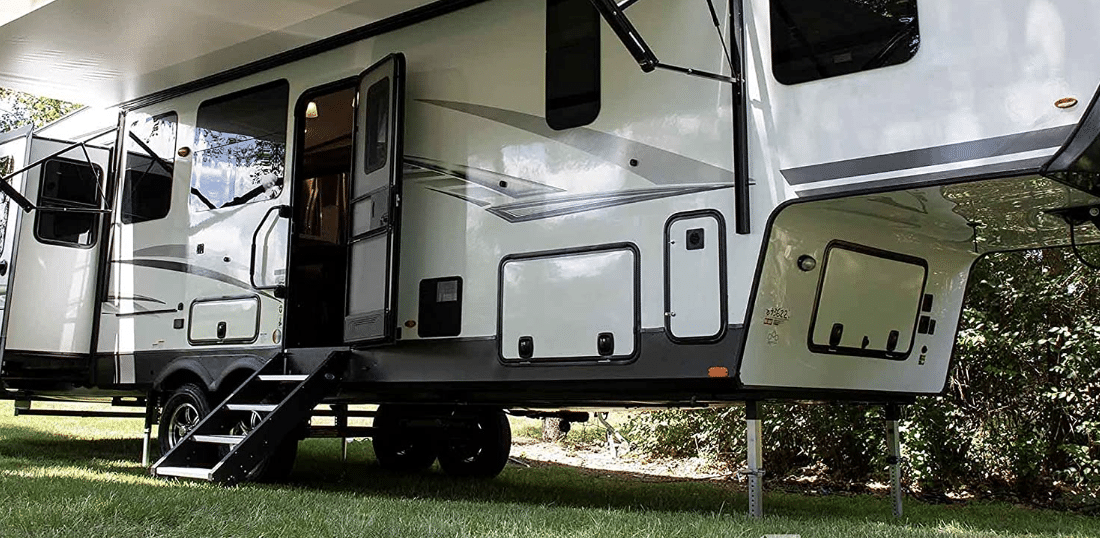
With hydraulic jacks, you don’t need to manually set anything up! If you have a larger rig (or have trouble cranking manual jacks on your own), hydraulic jacks will be perfect!
If your RV doesn’t come with hydraulic jacks already, you are able to add them on! Most systems are pretty easy to install and will simplify your stabilizing process.
Interested in installing some new hydraulic jacks into your rig? We highly recommend these ones by Lippert:
- COMPATIBILITY — Designed to replace Level Up Hydraulic Jacks for the front, rear, driver, or passenger locations of your 5th wheel RV or travel trailer’s automatic leveling system
- EASY INSTALLATION — With minimal components needed, it’s easy to remove your RV’s old jack and replace it with this new aluminum, hydraulic jack
- RELIABLE STRENGTH — Engineered with an 8,000 lb. lift capacity, this large, aluminum landing gear replacement jack was built tough with a 9” footpad, and 13 mounting holes — this jack assembly has a coach rating of up to 32,000 lbs. gross vehicle weight rating (GVWR)
- REPLACEMENT PART — At Lippert, we help you take the guesswork out of replacement parts with exact-match components designed to get your RV’s equipment up and running as usual
- IMPORTANT INFORMATION — Please reference your owner’s manual for detailed product installation and safety information before installation
3. Electric Jacks
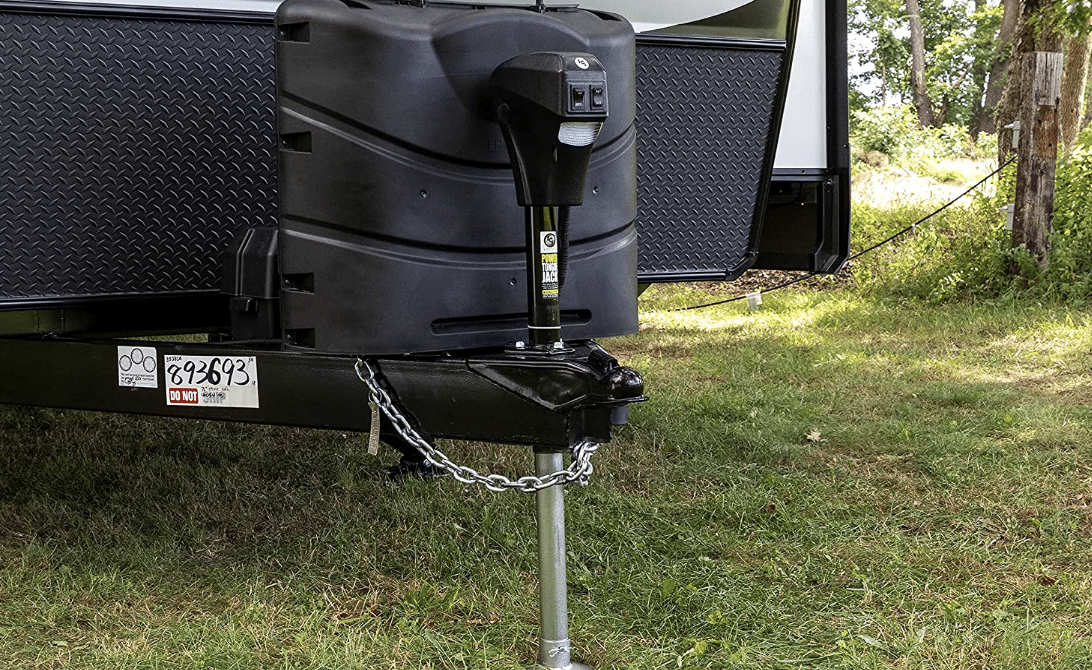
Electric jacks help you to set up your campsite easier and faster than ever. This stabilizer jack uses a 12-volt DC electrical power, typically from the onboard battery, to electrically extend or retract the trailer leg.
We highly recommend this electric jack from Lippert – it’s engineered with 30 AMPS of power and comes with four integrated LED lights that conveniently shine on the coupler (just in case you have to use this at night). Not to mention, it’s efficient (and very quiet):
- EASY INSTALLATION — Complete with all necessary hardware and pins, installation for the Power Tongue Jack is fast and simple, so you can get to lowering and raising your equipment in no time
- TIME-SAVING — Say goodbye to cranking your manual jack. With the push of a button, you can raise or lower your a-frame trailer in a fraction of the time, without breaking a sweat
- INTEGRATED LIGHTING — Four integrated LED lights illuminate the ball and coupler, so you can operate your jack at night, worry-free
- POWERFULLY ENGINEERED — Built to do heavy lifting, the Power Tongue Jack has a 3,500 lb. lift capacity, helical-cut gears, 30 AMPs of power, and a 12V motor — all designed to get the job done, quietly and efficiently, so you don’t have to
- BUILT TOUGH — Made from heavy-gauge, steel construction, a durable, textured housing that prevents chips and cracks, and a black powder-coat finish — this jack was designed to operate, day after day
4. Screw Jacks
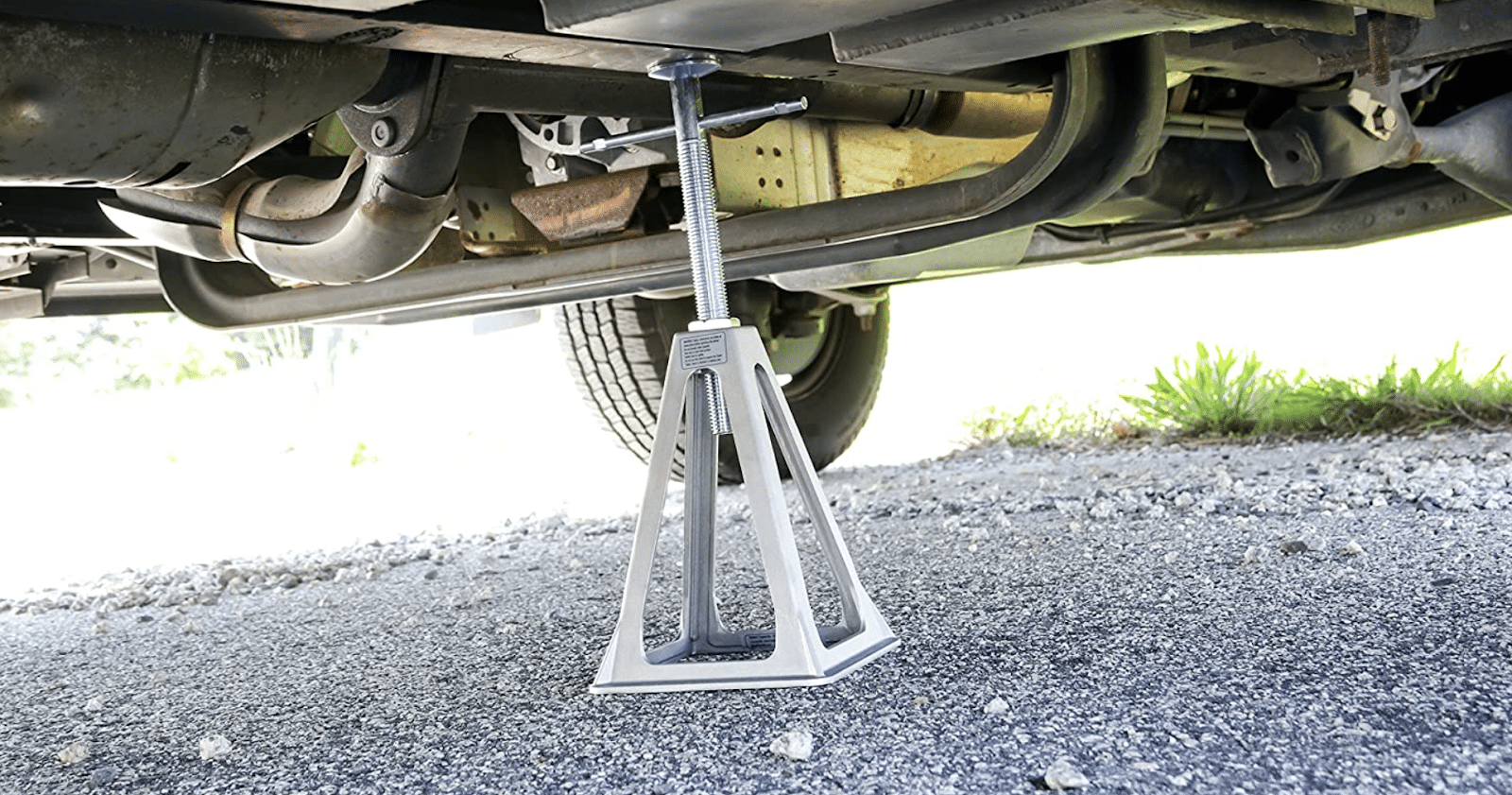
If you’re looking for a cost-effective way to stabilize your RV, screw jacks are for you! The aluminum construction is what makes them lightweight, yet strong enough to easily hold 6,000 pounds.
Because screw jacks don’t mount or secure to the RV, you’re able to easily adjust them as well as move them around your camper! We’d highly recommend these Camco Screw Jacks:
- UNMATCHED RV STABILITY: Stabilize your RV with Camco’s Aluminum Jack Stands for unmatched steadiness! This durable camper accessory prevents wobbling, ensuring a peaceful camping experience without unwanted movement.
- FAST, SIMPLE SETUP: Streamline RV leveling and stabilization effortlessly. Level your trailer, then place the jacks under your vehicle & adjust the height to make contact with the trailer.
- HEIGHT ADJUSTABLE: Easily adjust the height of this trailer accessory from 11″ to 17″ for stable support on any terrain. Raise each jack to the desired height for proper leveling and stabilization.
- PRECISION ENGINEERED: Built to last, this RV leveling system is made from robust cast aluminum and can support up to 6,000 lb per jack. For your peace of mind, this RV camping must-have provides RV leveling you can always depend on.
- QUANTITY: This RV accessory includes a set of (4) stack jacks for simple vehicle stabilization.
5. SteadyFast Stabilizers

SteadyFast stabilizers are designed to give the best possible movement reduction for a parked fifth-wheel or travel trailer while also providing an easy (and convenient) setup. If you have a heavy rig, SteadyFast jacks are one of your most popular choices!
It takes a few hours to install the system (which includes adjustable strut braces fixed on two adjacent sides of the rig). After that, you fix these braces on the other end of the landing gear in a sort of triangular shape. The shape, as well as the fact that the jack touches the rig at three different points for support, makes this jack incredibly stable.
We’d recommend getting these SteadyFast stabilizers:
- Best Performing Stabilizer System, ONLY 60 SECONDS to SETUP, No need to crawl under trailer, No Storage Space Needed, Made in USA,
- Only Available in Dark Grey. Permanently installed in 2-3 hours.
- Works on 5th Wheels and Travel Trailers with existing stabilizer jacks. If your trailer has an auto leveling system Please order our Item C..
- Eliminates Need for Tripod. Between Wheel Chocks, and Slide Out Jacks or any other parked trailer stabilizers
6. Drop Leg or Drop-Down Jacks

Drop-down jacks (also known as drop leg jacks) are another type of RV stabilizer jack. These mount to the frame of your RV and retract upon themselves when not in use. They typically come in both automatic and manual options, too!
A lot of higher-end systems will often use heavy-duty drop-down jacks as a part of their auto-leveling system. With the press of a button, your RV will be able to level and stabilize itself! Keep in mind that not all drop-down jacks are able to handle a heavy RV (so don’t overload your jacks).
We’d recommend these drop-down jacks:
- 【Camper Slide Out Supports】Provides support for the slide rail when extended, which can effectively solve the problem of sagging and bending of the slide rail and help improve the stability of the trailer.
- 【Adjustable Height】Each support jacks for trailer adjusts from 12″ to 18″ high and can hold up to 1,000 lbs. Plain tops fit most slide-out frames.
- 【Durable Design】The rv slide out supports stabilizer jacks are constructed of heavy-duty steel and zinc powder-coating finish, providing maximum strength and longevity.
- 【Easy To Use】 2 rv supports for slide out per case, easy to use, no assembly required. With incremental locking positions for quick and easy height adjustment.
- 【Quality Assurance】If the slide out supports for travel trailer ever fail on using simply contact us for a replacement. Save time and money by purchasing this part.
7. Permanent Jacks
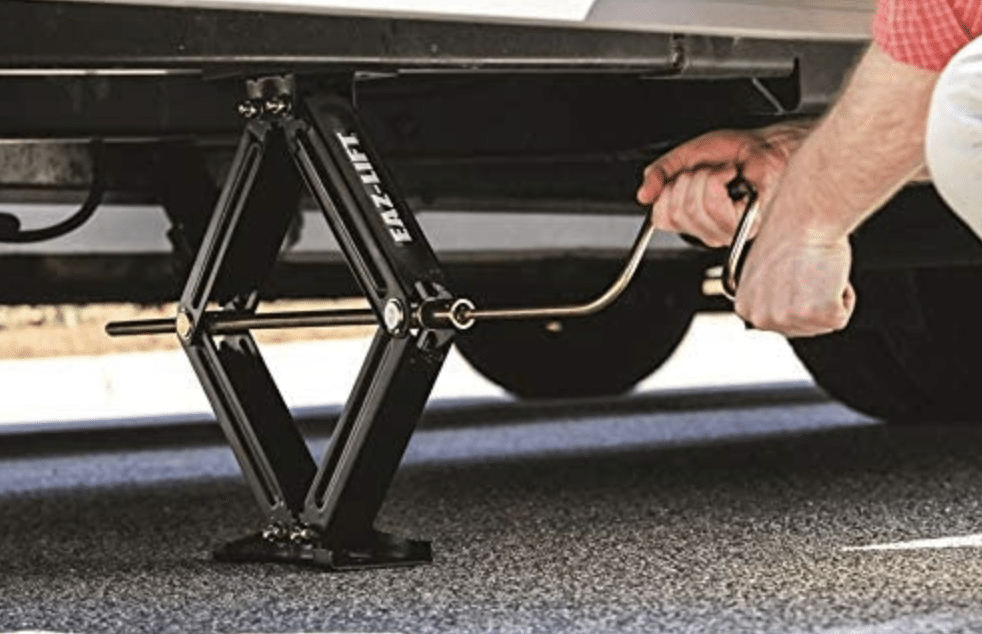
Most jacks are able to be permanently installed underneath your RV (which is a great space-saving hack as it’s one less thing to store in your RV).
Unlike tripod jacks, nearly every jack on our list is able to be bolted under your RV’s frame and retracted when you need them. Tripod jacks fit into your kingpin (which you’ll need for hitching your RV to the tow, so you’re unable to install these permanently).
If we were to recommend an awesome permanent jack, we’d go with the Camco Eaz-Lift:
- Effortlessly Stabilizes RVs: Scissor jacks have a certified 7500 lb. load capacity
- Easy to Install: Allows either bolt-on or weld-on installation
- Adjustable Height: Can be adjusted from 4 3/8-inches to 23 ¾-inches high
- Includes: (2) scissor jacks and (1) scissor jack socket for power drill
- Stabilizes a Variety of Vehicles: Designed to stabilize pop-ups, trailers and other large vehicles; Durable Construction: Made of heavy-duty steel and powder-coated for maximum rust protection
8. Tripod Jacks
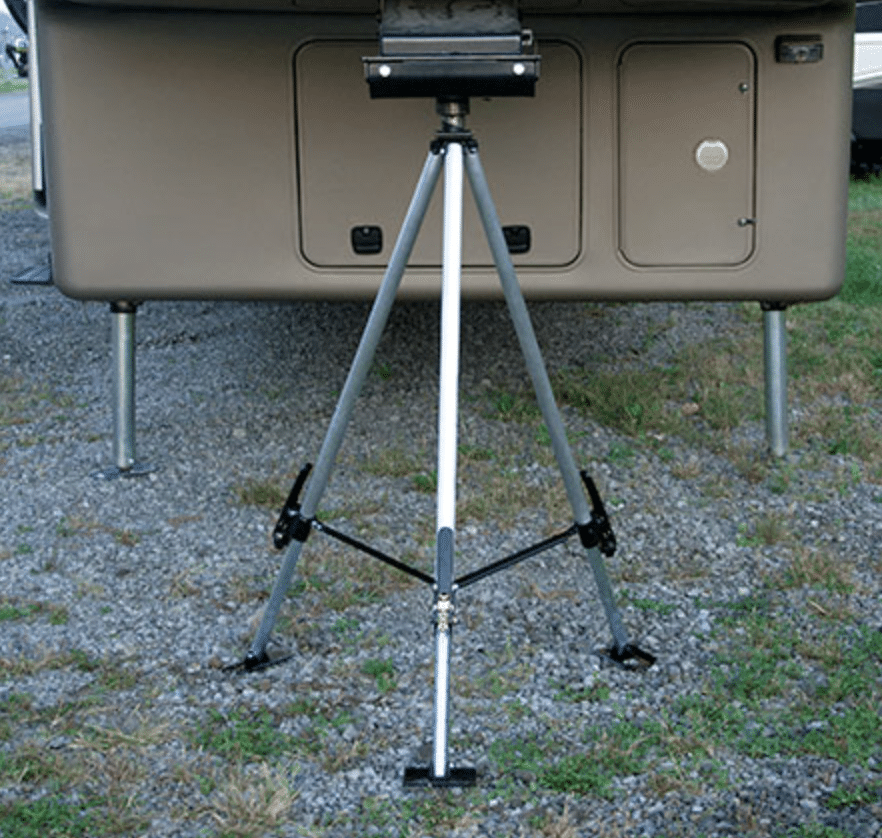
Having a fifth wheel is great, however, you might need some extra stability. This is where a tripod jack comes into play! Tripod jacks are able to give you three new points of contact with the ground, which helps to absorb more movement and vibration.
For the most part, tripod jacks shouldn’t work alone and have a weight capacity of 5,000 pounds. When you do purchase a tripod jack, be sure to find one where the legs are able to be individually adjustable as it makes it easier for you to set it up on the ground if it isn’t level!
We recommend getting this one:
- 5TH WHEEL TRIPOD STABILIZER: Camco’s Eaz-Lift RV fifth Wheel Stabilizer offers the ultimate stability and support for your fifth wheel trailer. It easily adapts to varying heights of coaches for a secure fit every time!
- COMPATIBILITY: This fifth wheel tripod stabilizer is specifically designed for use with fifth wheel trailers.
- LOAD CAPACITY: Its heavy-duty construction can hold up to 5,000 lb. Enjoy peace of mind knowing you have reliable support on your journeys!
- ADJUSTABLE: With an adjustable range of 38 1/2″ to 50″, this camper stabilizer is ideal for most vehicle sizes. It’s an RV must have for anyone with a fifth wheel.
- EASY TO USE: Installing this camper essential is a breeze! The foot pads adjust inward or outward for major adjustments. Make minor adjustments with the provided stabilizing adjustment lever.
9. Full-Width Double Stabilizers
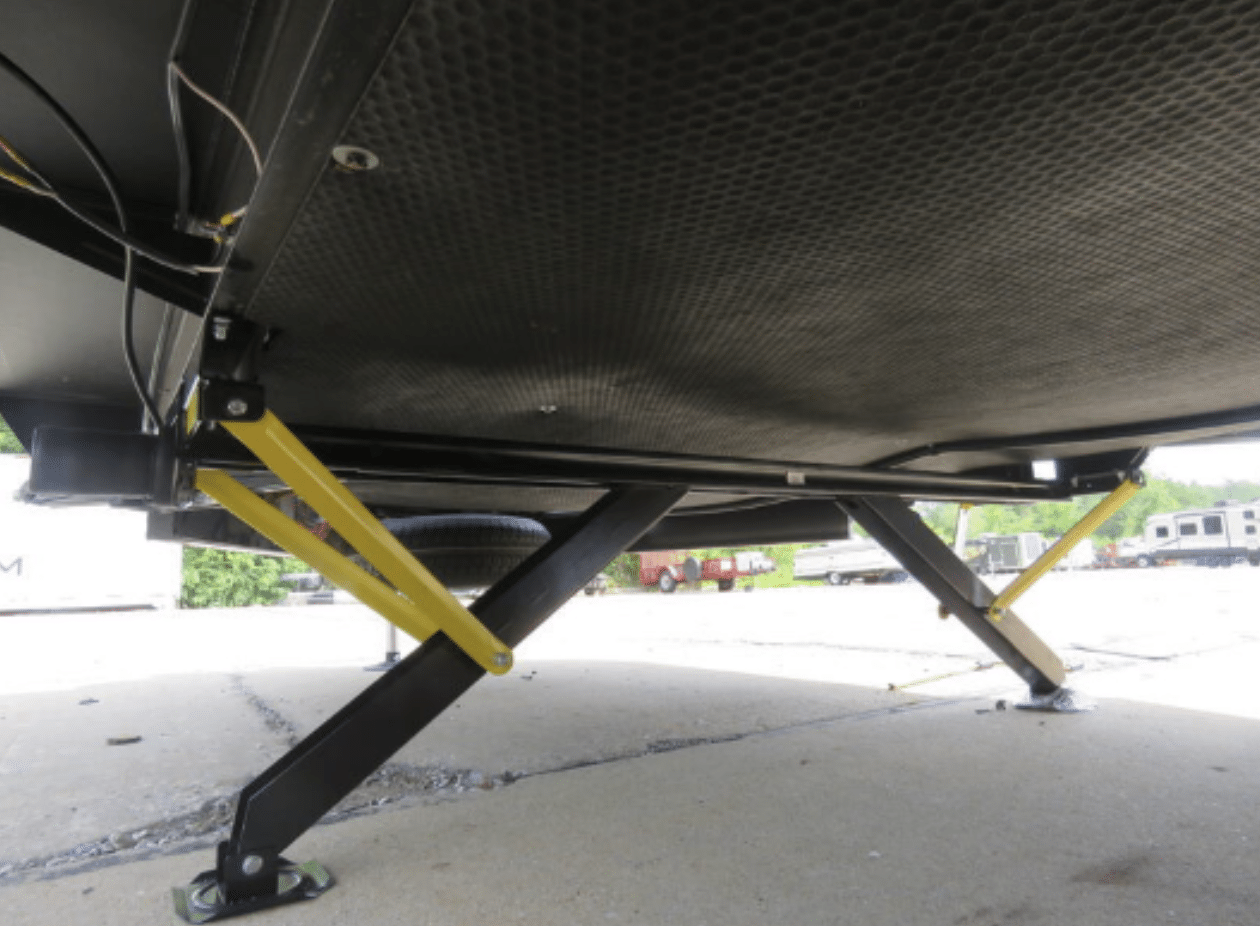
Double stabilizers are incredibly convenient and easy to set up. They have legs on both sides, so if you’re in need of a quick and easy way to stabilize your RV these will do the trick.
Each leg comes down simultaneously to save you some time and is available in both manual and electric varieties (however, the electric setup is what we’d recommend). Electric, full-width double stabilizers can do the job of stabilizing your rig with the push of one button.
- POWERFULLY DESIGNED — No more cranking. With the PSX1, campers can stop wasting time and energy with manual cranks. A flip of a switch is all it takes to take the sway out of your RV or trailer
- RUGGED VERSATILITY — We designed our stabilization system to automatically adjust to uneven, rugged terrain. Each leg operates independently, navigating the surface until safely secured in place
- DURABLE CONSTRUCTION — Built with heavy gauge steel, embossed legs and a powder-coat finish — when it comes to durability, this power stabilizer was made to withstand the elements and perform with efficiency, day after day
- INTELLIGENT INNOVATION — The PSX1 is equipped with integrated breaker technology designed to protect users from damaging their RV by tripping the breaker if the circuit is overloaded while lifting the trailer — also helping prevent side-to-side movement while extending and retracting
- MULTIPLE CONFIGURATIONS — Available in three configurations: black with a switch, white with a switch or without a switch
10. Universal Stabilizers
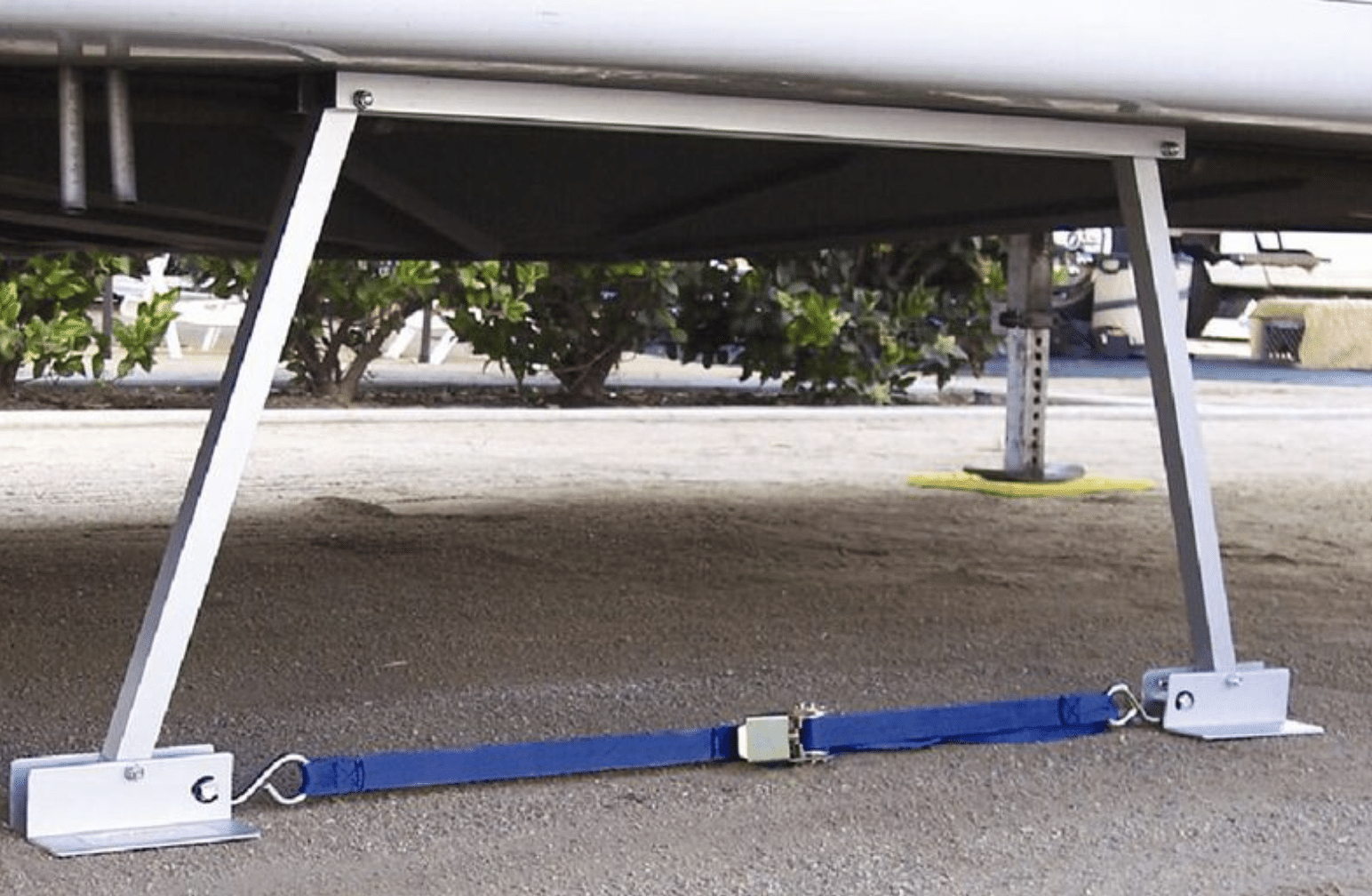
As you can probably tell by the name, universal RV stabilizers are able to be used on nearly any type (and size) trailer, cargo carrier, RV, and fifth wheel (a permanent trailer jack would be a lifesaver, too).
Universal stabilizers also have two adjustable legs that are mounted onto a single beam that you’re able to insert under your RV’s frame. From there, adjust the legs, strap them together using the strap that comes in the package, and then ratchet the strap and make sure the jack fits tightly under the frame.
We’d recommend grabbing these:
- Folds for easy storage
- Using two–front and rear or on both sides–makes RV rock solid
- Sets up in minutes, no tools needed
- Fits frames 14″H to 28″H
Bonus: Accessories
- MORE STABILITY — This stabilizer gives you the ground support you need to eliminate unwanted bounce and instability when going in and out of your RV
- PROTECTION — The Solid Stance even helps protect your bottom entry step from wear and sagging
- ADJUSTABLE — Compatible with height ranges of 5” to 14”, this kit comes with dual, individually adjustable legs that have four adjustment angles to adapt to uneven terrains
- EASY INSTALLATION — Set up only takes 15-20 minutes — plus, this kit stays attached to your steps for easy storage. No dismantling and reassembling required
- COMPATIBILITY — The Solid Stance fits all Lippert double and triple Steel Radius Entry Steps and double and triple Alumi-Tread Hybrid Aluminum Entry Step configurations, plus a wide-variety of competitor assemblies
- Heavy Duty: These leveling blocks for RVs are made from super strong and durable 100% recycled plastic, providing heavy duty support for your camper trailer RVs.
- Versatility: These trailer blocks are designed to fit a variety of jacks, such as RV tongue jacks, horse trailers, boat trailers and utility trailer jacks, making them versatile and convenient.
- Makes leveling easier: With these RV blocks for leveling, setting up your camper becomes a breeze. Simply place them under the jack and adjust as needed for a perfectly secure setup.
- Made in USA: Proudly made in America, these RV stabilizer blocks are crafted with quality and precision, ensuring reliability and longevity.
- Patented Design: OX BLOX trailer leveling blocks are designed by engineers in Utah to create a super stable, strong, and durable block. Patented: US 11,673,440 B2.
Vevor Jack Block Stabilizer
- · Solid HDPE Material: Made of high-quality HDPE, this ultra-tough trailer jack block accommodates vehicles up to 6,500 lbs/2,949 kg for a single block. The bright red color ensures high visibility in dim conditions. You will be surprised how stable everything is when using this strong and durable block with your stabilizer jacks!
- · Less Rocking & Stress: VEVOR trailer block can eliminate virtually all movements in your parked Trailer! It will actualize fully 90% less swaying when others are moving around inside your camper. Due to the width of the jack block, your trailer or rig will be less stressed.
- · Recessed Area for Better Leveling: Recessed Pad Area: 9.13″/23.2 cm diameter; Recessed Post-Hole: 2.44″/6.2 cm diameter. They help prevent jacks from slipping and work with scissor jack, post jack, pad jack, tough jack, and more.
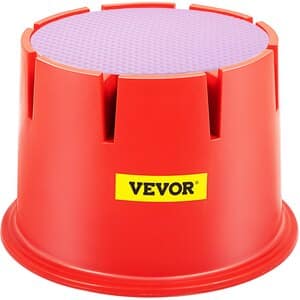
So Which Camper Stabilizer is Best?
Honestly, it’s up to you and your needs!
Would you rather have permanent RV stabilizers? Or do you want to be able to store them when you’re done using them?
While we’re pretty impartial to the classic scissor jack style, there are plenty of great models on the market today. As long as you have something that’s able to keep your rig steady on uneven ground, you’re in good hands!
Frequently Asked Questions
Have a question that wasn’t answered above? We’ve got you covered!
Where Do Stabilizer Jacks Go on an RV?
Typically, stabilizer jacks are located at the front and rear of units. Be sure that each jack is in place when it touches the ground and try not to extend it any further as it can get stuck or damaged in the process.
How Many Camper Stabilizer Jacks Do You Need?
That answer really depends.
For lighter RVs, two stabilizer jacks on either side will be able to do the trick. However, we do recommend you have one under each corner. If you’re using a trailer, you should add stabilizers behind the tires as well for added stability.
Simply put, the more stabilizers you add, the better stability you’ll get. There’s really no limit to how many you can add!
How Tight Should Travel Trailer Stabilizer Jacks Be?
A common mistake you can make with your travel trailer stabilizers is having them too snug. While you want them to be snug, you don’t want them to be too tight.
Get to the point where there’s tension on them, but not so much that you’re lifting your RV. It’s very easy to over-tighten your stabilizer jacks, especially if you’re using a drill to do the job.
Should You Put Blocks Under Stabilizer Jacks?
Yes, absolutely!
You should always put blocks under stabilizer jacks. This protects your RV but the soft ground at a campsite as well. Some RV resorts and campgrounds require a barrier between your leading gear and the campsite surface, too.
Are RV slide out stabilizers necessary?
That depends, is your RV an older or newer model?
If you have a newer RV, you don’t need to use slide out stabilizers. In fact, they may do more harm than good – your rig has slide outs that are electronic and automatic, therefore you may not have to support them at all!
With an older rig, though, they can be necessary. RVs with manual slide outs or pop outs may benefit from using them as they’re able to provide peace of mind should you have a shaky slide out!
And there you have it! With this complete guide on RV stabilizer jacks, you can now confidently choose the perfect solution to keep your RV steady and sway-free. No longer will you have to deal with that pesky wobbling while walking around your home on wheels. So go ahead, invest in the right stabilizer jacks for your RV, and experience the comfort and stability you deserve on your next adventure!
Looking for more content? We’ve got you covered:











